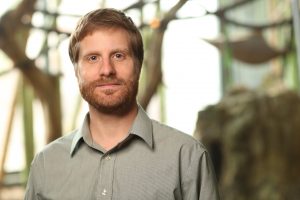This season of One Book, One Chicago, we explore the theme Season For Change through Elizabeth Kolbert's book The Sixth Extinction.
But what about the animals right here in the city of Chicago? We asked Seth Magle, director of Lincoln Park Zoo's Urban Wildlife Institute, to share his thoughts.
Seth Magle first became interested in conservation and ecology as a college student while observing black-tailed prairie dogs living in sidewalk median strips near his home in Boulder, Colo. Daily interactions with these resilient animals made him wonder what adaptations enabled these small mammals to survive in highly urban habitat. Eventually he completed an honors thesis on the behavior of this urban-adapted keystone species; he ultimately expanded on that research for both a master’s degree (from the University of Wisconsin) and a doctorate (from Colorado State University). However, Seth’s interests go far beyond prairie dogs to encompass all wildlife species impacted by urbanization and human development. He has researched urban wildlife species for over 20 years and published nearly 50 research articles. He is the director of the Urban Wildlife Institute at the Lincoln Park Zoo in Chicago, and also the executive director of the Urban Wildlife Information Network, an alliance of urban wildlife researchers spanning 23 cities. His vision is to help create a world in which urban ecosystems represent an important component of the worldwide conservation of biodiversity.
In Plain Sight
It was supposed to be a softball question. I was working for a zoo, she was interviewing to work at a zoo, so when it got to be my turn, I just said; “So why do you want to work at a zoo?”
And she started off great. She kind of sat up straighter in her chair like this was a question she’d prepared for. She was so eager, almost vibrating. You could tell she really wanted the job. And she said; “I love zoos, because for most people, it’s the first place they ever see a wild animal.”
I think I jumped out of my own chair, but I know at least I leaned way, way forward and started speaking very quickly. She knew right away she’d said something wrong, or, at least, wrong for the room. Okay, maybe just the part of the room that was me.
Because, as I sputtered, probably like a lunatic, that’s so, so wildly wrong. There’s no way any of us make it more than a week or two into our lives without peripherally seeing some kind of wildlife. An ant. A squirrel. A rabbit. Something, anything. We’re surrounded by wildlife every day, no matter where we live, no matter how little we care.
But those don’t count, do they? That seems to be the consensus. When we say “wildlife,” we aren’t thinking of rats and pigeons. We mean tigers and parrots and capybara and maybe foxes. This is the part where I drag up the dictionary definition of wildlife, which is usually, “undomesticated animal species.” Yes, technically urban things count. But they should actually count, too.
I think the reason that they don’t rate for most of us has to do with commonality. The connotations on the word wildlife seem to imply something rare, something fierce and above all, something far away. The implication, I suppose, is that humans used to live with wildlife, in our primitive past, but have transcended that experience. Now we just allow the wildlife to remain in the little preserves we’ve set aside, like the noble conquerors we are. That might be overstating it a bit, but it’s clearly nonsense, whether I made it up or not.
We’ve never not had animals in our cities. There are no records, for example, of cities without mention of rats. In a way, it’s a very cool trick wildlife pulled off. Not to convince us that they don’t exist, but to convince us that they aren’t much worth thinking about.
If we think of them at all, I think most people feel sorry for city creatures. There is an implication that they would rather be elsewhere, that they thrived in the prairie or the forest, and now they’re forced to make do in a pale reflection of their home. This narrative may even hold for some species, but for the most part, the ones that can’t adapt to the city, didn’t, and they’re gone. The ones we have left aren’t struggling; for the most part, they’re thriving. Urban raccoons and coyotes live longer and have more offspring than their “wild” counterparts. Bird species from robins to cardinals to red-winged blackbirds are crushing it. And that’s all without even invoking all the pests, the geese and the pigeons and the mice. We have created a new ecosystem, and it has winners and losers, just like the rest.
But the winners thrive by being invisible. A city coyote that eats rabbits and minds her business could very well live a long, rich life, if she looks both ways before she crosses the street (most do). But if she sleeps in the middle of the road or starts approaching people for handouts, she’ll be the subject of a call from animal control. It must be a tricky sort of dance, living completely surrounded by people and yet making sure none of them ever notice you. We don’t see them as wildlife, and I sometimes wonder if they even perceive us as fellow animals, or something else—an ever-present hazard, maybe, like disease or flooding or fire. Great rewards come with great risks, and all the food and water and sheltering structures we leave around must be tempting indeed.
The carnivores, at least, always look a little sheepish when I spot them. That’s anthropomorphizing, of course—ascribing human emotions to animals that likely don’t feel anything like them—but that’s how it seems to me. Coyotes, foxes, raccoons, they usually hunch down and bristle a little, holding very still in case maybe I didn’t see them after all, then they bolt when it’s clear that’s failed. It is easy to imagine that they’re ashamed that the camouflage didn’t work—but likely fearful, too. We are the threat to them, and they would otherwise stand on top of the new food chain. The wolves are gone, and the puma.
It’s played on a new board, but it’s still the same fundamental game for animals in the city. Find food, find water, find a mate, get out of the weather. It didn’t stop just because we stopped watching it.
To learn more and to find out how you can help the animals that call Chicago home by volunteering with projects like the Chicago Wildlife Watch, visit the Lincoln Park Zoo's Urban Wildlife Institute.




Add a comment to: Guest Blog: Seth Magle of Urban Wildlife Institute